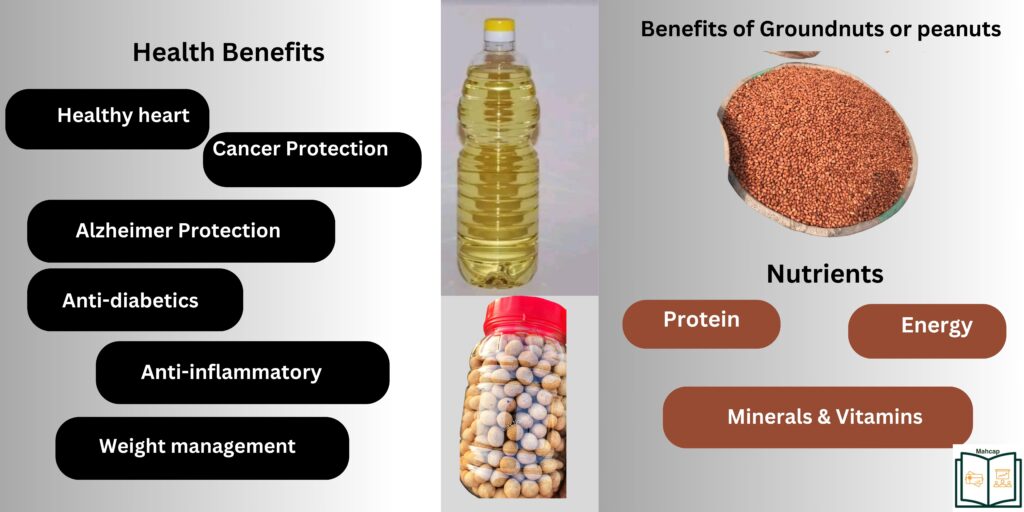Nutrition and Health Benefits of Groundnuts/Peanuts
Groundnut is an important oilseed crop cultivated globally for human consumption, forage, and income. Groundnut is good for weight loss, improves heart conditions, and protects people against cancer due to its richness in nutrients like proteins, fibre, minerals, and vitamins.
It is produced globally due to its health benefits. Asia and Africa produce 94% of groundnuts globally. Africa, with 46% of the global groundnut area, produces 24% of the global groundnuts. Meanwhile, West Africa produces 70 percent of groundnuts in Africa, with Nigeria being the biggest producer1.
Nutrient Composition of Groundnut or Peanut Seed
Arachis hypogaea is also called groundnut or peanut. Groundnut seeds can contain a substantial amount of oil (44 to 56 percent), protein (22-30 percent), fatty acids (40-50% percent), and carbohydrates(10-20 percent). It also contains calories, various vitamins and minerals2.
Uses of Groundnut or Peanut
Groundnut has many uses, including.
Food consumption

Cooking Oil
peanut or groundnut oil is recognized for its mild, pleasant fragrance and delightful taste. It is ideal for frying and is especially suitable for high-temperature frying, which ensures that food cooks rapidly, achieving a crispy exterior while absorbing minimal oil. Groundnut oil is easily digestible as well(1).
Groundnut Flour
Groundnut flour, also called kulikulizim in Dagbani, is made from raw, clean groundnuts, which have been roasted and naturally processed to obtain groundnut flour. Groundnut flour is used to thicken soups, stews, and sauces. It is also used as a confectionery and bakery product and as a flavouring agent.
Groundnut Snacks
Groundnut or peanut is also consumed as a popular snack, especially when roasted and seasoned. Different coatings can be applied to groundnuts prior to and after roasting to provide a variety of products, including flavours such as honey, salty, sweet, hot and spicy. Fresh groundnuts in shells can also be boiled in salted water and eaten as snacks. NASA of the United States of America has selected groundnut as a possible food for the Advanced Life Support system for extended space missions3.
Groundnut or Peanut butter
Groundnuts are roasted, blanched, and sorted before grinding into a creamy consistency called groundnut or peanut butter. The butter is used for cooking soups and as a spread for bread snacks. It is also used to add flavour to many foods, including pigeon peas when cooking.
Confectionary Applications
Groundnuts are often used in the production of various candies and sweets.
Industrial Uses
Some industrial applications use peanut oil as a base for paints and coatings and in soap manufacturing.
Nutrients and Health Benefits of Peanut or Groundnut
Groundnut seeds are proven to be an excellent source of the following nutrients.
Nutrient Benefits
Protein
Groundnuts are good sources of proteins and, therefore, an important crop in meeting the oil and protein demands in daily diets in developing countries.
Minerals and vitamins
Groundnuts contain potassium, calcium, phosphorous, and magnesium. Also, three forms of vitamin B1 exist in groundnuts: thiamine, thiamine-monophosphate, and thiamine-pyrophosphate. Hence, an ounce of groundnuts can meet the daily dietary requirement of several important vitamins and minerals.
Energy
Groundnuts have a high-energy value (average 564 calories/100 g seed).
Health Benefits of Groundnut/Peanut
What are the health benefits of peanuts or groundnuts?

Improves Heart Health
Groundnut oil contains absolutely no cholesterol. Groundnut oil contains mono-unsaturated fatty acids, which are good for the heart as they lower the level of bad cholesterol in the body without lowering the levels of good cholesterol. Studies consistently show a reduced risk of heart disease when groundnuts are consumed in small amounts daily. Research showed that those who frequently ate peanuts had a lower risk of heart disease. Hence, peanuts, peanut butter, and peanut oil all help prevent chronic diseases, including heart disease4.
Anti-Inflammatory Effects
The presence of certain compounds in groundnuts, such as resveratrol and other antioxidants, may have anti-inflammatory effects, potentially benefiting conditions associated with inflammation.
Protection Against Cancer
There is strong evidence that groundnut product consumption protects people against different cancers like breast, colon, and prostate. A decade-follow-up study showed that peanut consumption may help reduce the risk of colorectal cancer in women(3). Groundnut nutrients like folic acid, phytosterols, phytic acid, and resveratrol have anticancer effects. This suggests that groundnut and their by-products can be used as natural chemotherapeutic or chemopreventive agents.
Protection Against Alzheimer’s Disease
Groundnut oil is a rich source of vitamin E and other phytochemicals. Niacin and vitamin E are two important constituents that provide protection against Alzheimer’s disease. Peanuts are beneficial in Alzheimer’s disease and other nerve degeneration diseases5.
Anti-Diabetic Activities
Groundnuts or peanuts have been proven to be beneficial in lowering the risk of type 2 diabetes. Researchers from the Harvard School of Public Health, in a prospective cohort study of more than 83,000 women, found that women who consumed groundnut butter had a significantly lower risk for type 2 diabetes. Women who reported eating nuts at least five times per week reduced their risk of type 2 diabetes by almost 30%, and those who ate peanut butter reduced their risk for type 2 diabetes by almost 20%, compared with women who rarely or never groundnut butter(1).
Weight Management
Despite being calorie-dense, the protein and fibre content in groundnuts can contribute to a feeling of fullness and satiety. This may help in controlling appetite and managing weight when included in a balanced diet.
Therefore, groundnut cultivation and consumption are good as they have a lot of nutrients and health benefits.
By: Huzeima Mahamadu (Researcher and Storyteller)
References
- Akhtar, S., Khalid, N., Ahmed, I., Shahzad, A., & Suleria, H. A. R. (2014). Physicochemical Characteristics, Functional Properties, and Nutritional Benefits of Peanut Oil: A Review. Critical Reviews in Food Science and Nutrition, 54(12), 1562–1575. https://doi.org/10.1080/10408398.2011.644353 ↩︎
- Sanni, J. A., Sanni, G. O., Awoniyi, R. R., Osanyinlusi, R., Richards, Y. E., Adesina, G. I., Adenuga, O. O., Apata, S. A., & Ekun, O. E. (2023). Effects of Processing on the Proximate Composition, Mineral Content and the Phytochemical Analysis of Groundnut Seeds (Arachis hypogeae) [Preprint]. In Review. https://doi.org/10.21203/rs.3.rs-3120097/v1 ↩︎
- Savage, G. P., & Keenan, J. I. (1994). The composition and nutritive value of groundnut kernels. In J. Smartt (Ed.), The Groundnut Crop (pp. 173–213). Springer Netherlands. https://doi.org/10.1007/978-94-011-0733-4_6 ↩︎
- Sabaté, J. (2003). Nut consumption and body weight. The American Journal of Clinical Nutrition, 78(3), 647S-650S. https://doi.org/10.1093/ajcn/78.3.647S ↩︎
- Yeh, C.-C., You, S.-L., Chen, C.-J., & Sung, F.-C. (2006). Peanut consumption and reduced risk of colorectal cancer in women: A prospective study in Taiwan. World Journal of Gastroenterology, 12(2), 222. https://doi.org/10.3748/wjg.v12.i2.222 ↩︎
